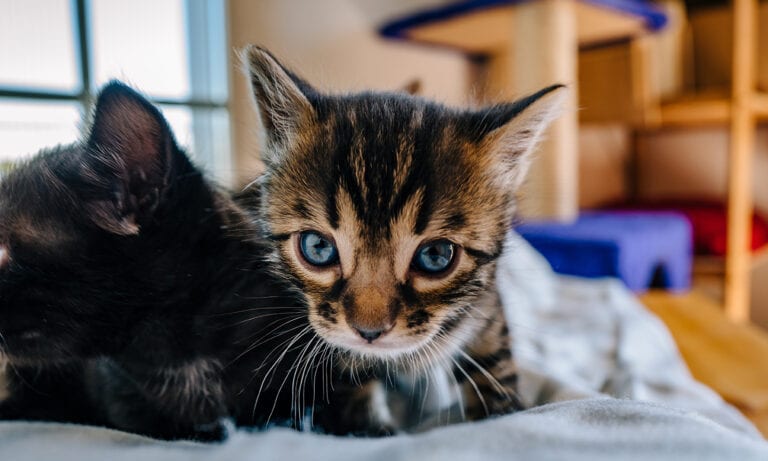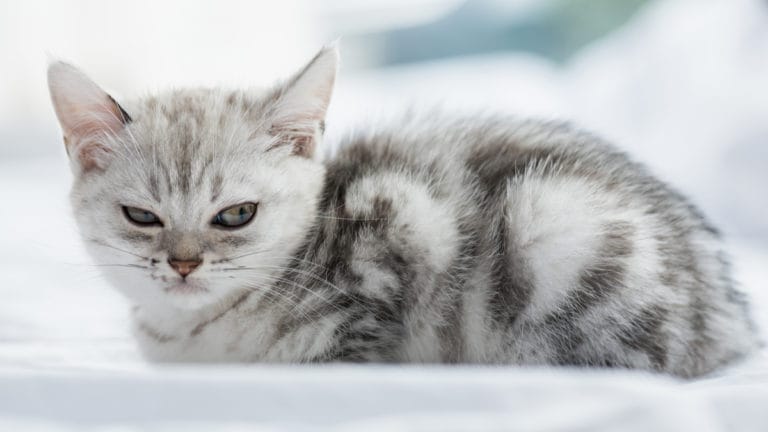There are plenty of adorable kittens just waiting for you to spoil them. But how do you choose the right kitten for you and your family? Understanding and identifying a kitten’s temperament will help you pick the purrfect feline companion (or two!).
The Right Age
There are many social cues and behaviors kittens learn from their mothers and siblings that they cannot learn from us humans. The critical time in a kitten’s socialization is ages 2 to 7 weeks, when their interactions with mom and siblings are shaping their future behaviors. It’s best if kittens stay with their mother until they are at least 12 weeks of age. The younger they are when you adopt them, the more you will have to teach them yourself when you get them home.
Look for a kitten who is alert and reacting to his surroundings. Clear bright eyes, a cool damp nose and shiny fur with no missing patches are all good signs of a healthy kitten. Along with good health comes that kitten hyperactivity you’ve no doubt experienced. Kittens can indeed be non-stop bundles of energy. It is through intense play with their siblings that they first learn social skills as they explore the world with one another. Playtime with their siblings is also how they sharpen those natural hunting abilities cats are known to have.
The Right Personality
Selecting the right kitten for your household will take a little investigation as you play with and hold the kittens. Ask yourself the following questions:
- Do you have other pets or young children at home?
- Are you at work for long hours?
- Will you be worried about things getting broken in your home by all that kitten energy?
Then, once you have your answers, determine which of the following types of temperament best suits your lifestyle.
1. High-Intensity Kittens
High-intensity kittens are fearless bundles of non-stop GO. You can spot them quickly; they’ll be the ones running after and jumping on their littermates. They seem to have endless energy as they race around at full speed, and they often wiggle around as you try to hold them. They cannot sit still for long, if at all.
These outgoing kittens will become assertive and fearless cats as they grow up. If you are looking for a cat who needs lots of interaction and mental stimulation, choose a high-energy, rough-and-tumble kitten. High-energy kittens and cats tend to get bored easily, so they do best when adopted in pairs. You’ll enjoy endless hours of antics with these cat clowns. But put away the breakables!
Although they love to play with their kitten buddies, high-energy kittens can also bond well with people. Offer lots of cat toys and cat trees to keep these rascals occupied, and play with them often so they’ll want to interact and bond with you. About 5 years ago, I adopted an extremely high voltage set of 8-week-old kittens, Boo-Boo and Pinky. Both were as high intensity as they come, getting into all sorts of things and really keeping me on my toes. As they’ve grown into beautiful adults, they have each retained their mischievous ways. Pinky and Boo-Boo are also my loving companions, who often sit on my lap and sleep close to my side at night.
Currently, I am fostering a brother/sister pair that are 10 weeks old, Sonny and Cher. They play together seemingly non-stop, and they aren’t afraid of my adult cats either. I am grateful they use up that high-octane energy on one another, and then come to me for cuddle time and love. I think my adult cats are grateful, too!
2. Low-Intensity Kittens
Low-intensity kittens are calm and secure. While they do play and interact with their littermates, you will notice they are not usually the instigators of aggressive play. When you pick them up, they will settle down quickly in your lap and purr happily as you pet them.
Self-assured and confident, these kitties can handle any situation, from being left home alone to playing rough-and-tumble with another pet. Low-energy kitties handle other pets and kids especially well, but can also be content as an only kitty. They love to sit quietly on their human’s lap just as much as they love cuddling with another cat. These kittens are the best of both worlds and will become calm and loving adult cats.
My 16-week-old Simon is one of these calm and loving cats. While he does play with my high-energy foster kittens, Sonny and Cher, Simon’s preference is to sit quietly in a sunspot or purr softly while sleeping on my lap or snuggling with one of the older cats.
3. Shy Kittens
If you see a kitten sitting off to the side, not really interacting with any of the other kittens, these are often the shy kittens who might prefer to be an only cat. They might seem nervous when you hold them and bury their heads under your arm or even shiver slightly when picked up.
Often, these are the kittens who were separated from their mother and littermates too early, and they didn’t learn how to interact with others. They may need a little extra help and patience to become social with you, but these kittens often become extremely loving and devoted cats. Be patient and give them time to adjust to you and their new home. Talk to the shy kitten in soothing tones and offer some yummy treats to help them trust you. Accept their level of interaction, but don’t ignore these shy ones. Having contact with you is crucial to helping the shy kitten learn to trust and bond with humans so he can become a loving adult cat.
My late cat, Precious, was a shy loner kitten. She had been abandoned by her feral mother at the tender age of 4 weeks and, as a result, had socialization issues. Precious and I shared a very close bond for her 17 years of life, but no other living being was allowed to touch her.
No matter which kitten you choose, he will need lots of extra care in those first few months of life as he learns about the world. As he grows up, you will enjoy watching him become a beautiful adult cat and a much-cherished member of your family.
By: Rita Reimers
Share:









